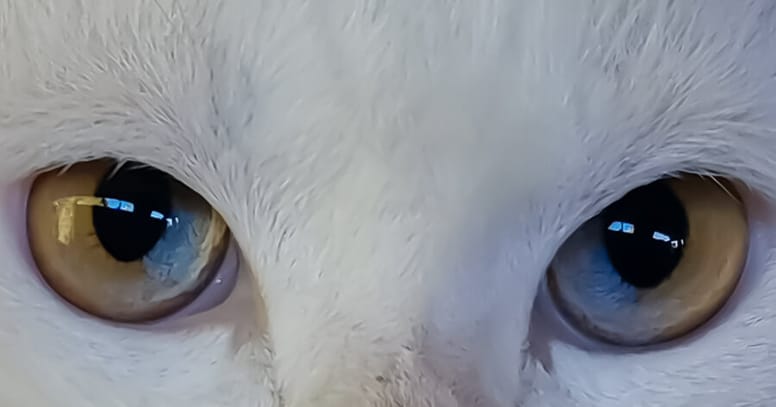The eye colours that cats can have are broad and various. They may be blue, copper, yellow, orange, green, red, one of each, or some kind of marble pattern.
As with humans, the coloured part of a cat’s eye is the iris – the next circle out from the pupil. The iris has two layers. Each of these layers contains melanocytes, which produce pigment (colour). This pigment is called melanin. The more melanocytes in a cat’s eye, the darker and more vibrant the colour. This is particularly notable in purebred cats. The parents are carefully selected for clarity of eye colour among other things. And like humans, their kittens inherit the genes of their parents, deferring to the dominant gene. Want to know more about the different eye colours cats can have? Let's take a closer look!
Cats with blue eyes

Blue-eyed cats are not rare, but they are genetically unusual. Some breeds always have blue eyes, while others have them sometimes.
All kittens are born with what appear to be blue eyes. In fact, there is not yet any pigment in them, and the blue colour is a trick of the light. But most kittens develop that pigment at around 6 weeks of age, and you’ll observe their eyes becoming colourful. Cats that don’t develop melanin end up keeping their blue eyes for good.
While fur colour is generally not linked to eye colour, white cats are much more likely to have blue eyes than any other colour of eyes. White cats with blue eyes have a higher percentage of genetic deafness at birth, but not all are affected by this.
In the purebred cat world, most cats with blue eyes are indeed grey, colour-point, or white cats, such as Balinese or Chinchilla Persians.
Cats with brown eyes

Saying cats have 'brown' eyes is not entirely correct. Cats' eyes can be instead various shades of copper.
Cats with copper eyes have produced a lot of melanin in their iris. The darkest cat eyes are no darker than a rich shade of copper. They may seem darker depending how much light is on them, or how intense they are. But they’re copper. Black-eyed cats do not exist.
This is a rather common colour, but an example of a breed that does show this eye colour, among others, is the Scottish Fold.
Cats with green eyes

Much like blue-eyed cats, cats with green eyes have produced very little melanin in their iris. The intensity of the green depends on the melanocyte activity. A low melanocyte activity will produce pale green eyes, while a high melanocyte activity will produce intensely vivid green eyes.
Any colour of cat can have green eyes, including white cats. The most stunning examples of purebred cats with green eyes include the Egyptian Mau, Oriental Shorthair and white Persian.
Cats with yellow or orange eyes

Yellow-eyed cats can vary in eye colour from a pale lemon to a vivid orange. This is due to the level of activity in the melanocytes, which influences the intensity of the eye colour.
This is why you'll have such variety in this type of eye colour. Low levels of melanocyte activity will result in pale yellow eye colours while high levels of melanocyte activity will result in intense, deep orange eye colours.
Turkish Vans and Bombays are beautiful examples of purebred cats who can display yellow eyes.
Cats with odd eyes

Sometimes we end up with a moggy whose eyes don’t match. This condition is called heterochromia. It does not affect the cat's vision at all.
Be warned that if you name your odd-eyed cat after David Bowie, then David Bowie fans will boringly correct you: the thin white duke did not actually have odd-coloured eyes. It’s just that one of them looked darker because one pupil was permanently dilated. For this reason, it is better to name your cat after Dan Aykroyd, a genuine heterochromia.
Being a genetic thing, heterochromia often recurs in the same breeds of cat. If you’re hoping to find one, put your name down for a Turkish Van, Turkish Angora, Japanese Bobtail, or Sphynx. No guarantee, but these breeds are more likely to have odd eyes than many other breeds of cat.
And it’s more or less the same deal as with blue-eyed cats. In the case of heterochromia cats, something in their genes prevents the melanin from developing in just one of their eyes. Cats with heterochromia are 20% more likely to be born deaf than other cats.
Cats with dichromatic eyes

A cat with two colours in one eye is a dichromatic cat. The presence of two colours, also known as a 'pie slice' just means that the melanin is unevenly concentrated throughout the irises. Though this is considered a flaw in the purebred cat world, most people find it incredibly charming. If your cat is dichromatic, it is probable that a modelling career awaits him/her.
Albino cats

Some cats produce melanin, but due to genetics, the melanin is masked or suppressed. A white cat with very pale blue or even pink eyes is a true albino. The pink in its eyes is from the blood vessels reflecting through from the back, because there’s no melanin to cover them up. Cats who have produced no melanin are technically not white, they're just no colour at all. This means they're not likely to suffer from deafness like many white cats, but they may have problems with their eyesight.
Cat eye colour and health
As mentioned above, around one in five odd-eyed cats are born deaf. Hearing problems are also common among blue-eyed cats, as the same gene that suppresses the melanin affects cells in the ears.
Once your cat is around 4 months old, its eye colour should not change any more. If you notice a change, you should get that cat to the vet. It could be a symptom of something wrong, such as glaucoma, an infection, cancer, or autoimmune issues.

